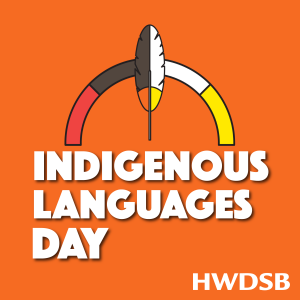
Indigenous Languages Day – March 31, 2023
Mino Bimaadiziwin – Good Life (Anishnaabemowin – Ojibway Language, Martina Osawamick, Odawa, Beaver Clan, Wikwemikong Unceded Territory)
Wa’tkwanonhwerá:ton – I to all of you am sending greetings, love and respect, in a balanced way from my consciousness to yours, with deepest heartfelt emotion, expressed audibly. (Kanyen’keha – Mohawk Language, Tehahenteh, Mohawk, Six Nations, turtle clan).

After careful consultation with Indigenous first language protectors/speakers, Martina Osawamick and Tehahenteh, we have agreed upon accurate and compatible terminology in Ojibway and Mohawk to convey messages that fit within the current context of ‘welcoming’ people into a colonial school setting.
The Indigenous Educational Wellness Team share the belief that the inclusion of messaging in Indigenous languages must be respectful of our history within ‘educational’ institutions and continue to honour Survivors. Mino Bimaadiziwin and Wa’tkwanonhwerá:ton carefully reflect an expectation of wellness and safety and are reflective of cultural mindsets that are always based on traditional cultural values.
Indigenous Languages Day has been observed by Indigenous Peoples in Canada since 1993, more than three years before the closing of the last Residential School. It would be another two decades before any mention of Residential Schools would be removed from the Indian Act.
When Indigenous Languages Day was introduced, it was intended to honour Ancestral language protectors, and the strength that they demonstrated to protect Indigenous languages and cultures in the face of legislative abuses that were imposed on the Original Peoples of these lands.
Many Indigenous languages are critically endangered and despite few Indigenous first language speakers, communities and nations understand how precious and critical language revitalization is to individual and collective healing and well-being. As an education space, on Indigenous land, we need to normalize the ethical and moral imperative of working in partnership with Indigenous communities to make language learning accessible in schools and classrooms.
We understand that historic treaty agreements, such as Kahswénhta, the Two Row Wampum, were agreed to by the Crown and the Haudenosaunee. Kahswénhta defines a clear delineation between – and protection of – the five tenets of sovereign nationhood status: Ancestral language, culture, ceremony, governance models, and connection to Ancestral territories.
Treaties are nation-to-nation agreements. If the Crown, Canada and the churches had succeeded, the defining nationhood criteria would have been eradicated. Then, as was the intention, Indigenous Peoples’ sovereign nationhood status would cease to exist according to Canadian legislation. The Crown’s fiduciary responsibilities to fulfill Treaty obligations would be negated.
The Indigenous Educational Wellness Team (IEWT) in friendship with HWDSB, provide the following: we understand that the education system is a colonial structure, and we are responsible for dismantling it alongside Indigenous Peoples. Through the Indigenous Education Circle Strategic Action Plan (IECSAP), and the Restorative Indigenous Educational Wellness Framework, we make intentional space to enable individual and collective ownership towards intergenerational educational wellness.
IEWT in friendship with HWDSB and the broader Kahwà:tsire – Zaagi’idiwin (Indigenous Education Family) commit to engaging in meaningful ways that are accurate, authentic and accountable to Indigenous communities (i.e., local/host nations).
Language reclamation and revitalization efforts is one path towards Restorative Indigenous Educational Wellness.
Mino Bimaadiziwin
Wa’tkwanonhwerá:ton
In Peace and Friendship,
Treaty Partners,
Jolene John, Indigenous Education Lead
Sue Dunlop, Associate Director, Learning Services
In addition to this Indigenous Languages Day message, please see this short story, an address to language learners/speakers/protectors/educators from Six Nations Artist and ‘Auntie Betts’ Elizabeth Doxtater (OCT), to complement a language learning journey:
To everyone who is learning, speaking and/or protecting an Indigenous language.
She was sitting by her computer, practicing words in the language that has been hidden from her family for generations.
‘Oh stoo ha.’
‘Try with more nasal,’ the on-screen instructor guides.
‘Oh stoonh ha.’ He nods.
That small phrase, that attempt, causes her face to turn red followed by an adrenaline rush.
The class ends for the day.
She gets up and walks to the kitchen and puts a teaspoon full of apple sauce on a saucer.
With a measuring eye, she repeats. ‘O stoonh ha.’
Dipping a cracker in the apple sauce, she returns to her computer to review the list of words that were provided as homework.
Days of the week, months of the year and types of weather.
To anyone who might be watching, this appears to be as romantic as memorizing multiplication tables, repeating over and over.
It looks boring. But the little sparks that were starting to awaken and flicker were ancient and powerful.
Rekindling a flame that was repeatedly stomped on and doused with fear and shame for so long, the flame that grew a tiny bit stronger with each attempt, is humbling.
We heal in many ways and at many paces.
Sometimes it’s ‘ohstón:ha…’
…a little bit!
March 31st is Indigenous Languages Day. Every Child Matters.
The Indian Residential Schools Crisis Line is available 24 hours a day for anyone experiencing pain or distress due to Residential School experiences. The number for the crisis line is 1-800-721-0066.
Updated on Friday, March 31, 2023.

